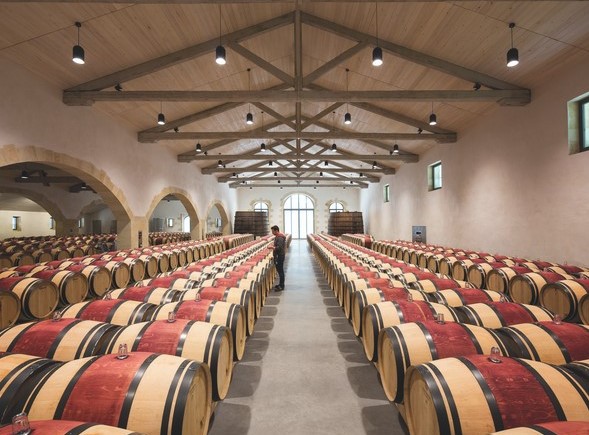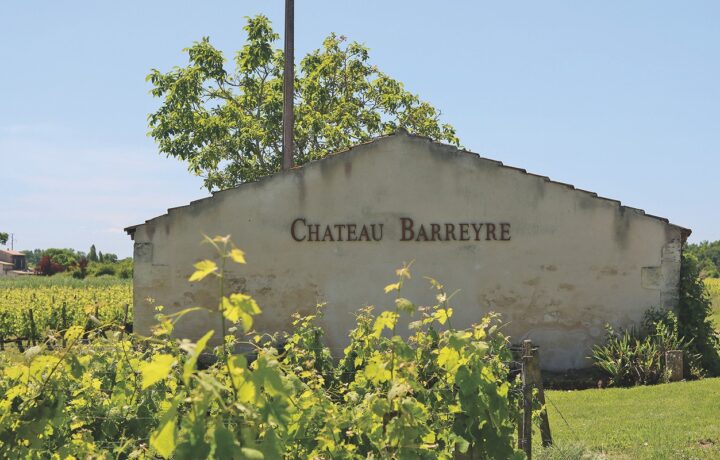
The 2021 harvest in Bordeaux looked problematic for many chateaux. Some complained about frost and mildew, others about late vine flowering, rain, and a lack of sun through mid-summer. Almost everybody suffered low yields that will result in an uncommonly short volume vintage. But on this side of the Atlantic, the trade isn’t worried. After a long streak of very good Bordeaux vintages, many in the U.S. agree that the region may need a breather of sorts—an escape valve that serves to actually tamp down volumes and prop up prices. Could America have too much Bordeaux?
“In the world of global warming, winemaking everywhere, including Bordeaux, has gotten much more consistent,” says John Kapon, chairman and majority owner of Acker Merrall & Condit, the fine wine retailer and auction house based in New York City. “The Bordelaise have made so much money in recent years that they can now afford to hold back. They can wait.” But maybe they can’t wait too long. In the first six months of 2021, after the U.S. tariffs on French wine were lifted, Bordeaux sales by volume exploded, rising 42% over the year-earlier period to 1.3 million cases, while value more than doubled to 192 million Euros, according to Impact Databank. But even with the tariffs in 2020, the year ended better than expected, with case volume up nearly 2% over 2019 levels to 2.2 million, according to Impact Databank. Over the past decade, only 2017 surpassed the 2020 totals, and only by a few thousand cases. Amid the depths of the 2008-2009 recession, Bordeaux shipments fell as low as 1.3 million cases as trend-setting French restaurants were closing and consumer tastes turned to Latin- and Asian-inspired cuisines.
Jeremy Noye, president and CEO of Morrell & Co. in New York, said that his Bordeaux sales were running up 18% in the fall of 2021 compared with a year earlier. He credits the region’s continued success to sheer quality, but also believes that savvy consumers are turning to France as Napa wines have escalated in price. “Bordeaux actually offers better value now than Napa does,” he says.
Of course, the Bordeaux comeback hasn’t reached the classified growths tier quite yet. With First Growth labels for recent vintages retail-priced at around $600 a bottle and many second-growths at $300, most merchants count on making their money in offerings from lesser-known petits-chateaux priced from $20-$70 a 750-ml. In that range, they say, Bordeaux competes well with selections from Napa and much of the rest of California. Even better values can be found in Spain, but Bordeaux isn’t far behind. In fact, Bordeaux recently regained its No.-1 ranking among the largest-selling wine regions in France, displacing Provence.

Absorbing Higher Prices
“Bordeaux is on fire for us right now, and it was already doing very well before the tariffs,” says Zachys Wine & Liquor wine buyer Michelle Weiss, who notes that, through October 2021, Bordeaux volumes were up 25% for the year to date at this single-unit store in Scarsdale, New York. Store president Jeff Zacharia attributes some of the sales gain to rising household incomes. “People who once popped a $24 Chianti are now looking at a $30 Bordeaux,” he says. “Bordeaux had a perception of being overpriced, but people are moving past that now.”
An average Bordeaux sale at Zachys falls at around $100, according to Zacharia, who points to such labels as the 2017 Chateau Leoville Barton ($90 a 750-ml.), as such a good value that the store has stocked 200 cases of it. What’s more, he adds, such wines once required years of cellaring before optimal drinking. Now they’re vinified in the more modern fruit-forward style that can be immediately opened and enjoyed.

In the middle of the country, such rarified price points are uncommon. At the 11-store Haskell’s chain in Minneapolis, CEO John Farrell Jr. says that “classified Bordeaux has been underwater for a long time. It’s out of reach for 99% of our customers.” While some people have turned to Oregon and the Rhône and even Croatia for alternatives, he says, recently many are coming back to lower-priced Bordeaux. “The petits-chateaux segment priced at $30 and below is healthier here than it’s ever been,” says Farrell, who pegs the center of his Bordeaux sales at $30. He singles out such finds as the 2016 Mille Anges Black Label ($20 a 750-ml.) as a particular success. “They’ve been making wonderful wines for the past 20 years there and we are probably their best customer in the world. Once you’ve sold a wine like this and people like it, they become loyal and keep coming back to it,” Farrell says.
Barbara Hermann, wine director at the 45-store Binny’s Beverage Depot chain in Illinois, admits that in recent years she has miscalculated her Bordeaux strategy, by staying focused far too long on classified wines. “I had an enormous selection of classified wines that I bought en primeur, and then a tiny assortment each year of three Bordeaux priced around $10,” she says. “But the $10 wines were selling out. My managers kept asking me why I didn’t get more of them. So now I’m stocking far more Bordeaux in the $10-$30 range.”
There was a reason for that blind spot at one time, Hermann says. Sifting through all 6,000 Bordeaux chateaux is difficult for any buyer, but negoçiants play a key role that is only growing as the lesser wines have improved. “Twenty years ago, I’d travel to Bordeaux and visit a negoçiant who had 100 petits-chateaux open for me to taste,” she recalls. “They were all terrible and I felt like I was wasting my time. Since then, many of those same chateaux have vastly upgraded their winemaking techniques and are making very nice, palatable wines.”
Hermann singles out such labels as the 2018 Chateau Haut Gaudin at $11 a 750-ml., though she notes that such finds are hit and miss in terms of getting supply. “I’ve sold 285 cases of that wine in the past two months, but once it’s all gone I may not be able to get it again,” Hermann says.
At the 161-store BevMo chain based in Concord, California, Olivier Kielwasser, category lead for all wine, reports that his average Bordeaux bottle sale is currently at $13 a 750-ml., actually under the $15.50 average for all wines in the chain. “We have a huge opportunity to premiumize our Bordeaux assortment, and we’re working on that,” he says.

A Return To Classified Wines
Kielwasser’s making a big move in the process. Recently BevMo has been featuring labels such as the 2018 Ballon-Larquette at $12.50 a 750-ml. He’s hoping to nudge his customers upmarket to the 2016 Chateau de Villambis from the Haut-Médoc at $25. But he’s got even bigger ambitions. In the face of skyrocketing prices, BevMo left the classified Bordeaux business in 2013. Now Kielwasser is re-entering the business, cautiously. He’s stocking, for example, the second-growth 2018 Gruaud Larose at $100. His wholesale cost is $70. He’s dealing directly with a negoçiant and cutting his import costs in the process.
“That way we can compete well against all the discounters,” Kielwasser explains. “In the end we’ll have a very decent margin on that wine. I’m anticipating that during the holidays our customers will be willing to trade up for gift-giving and will be interested in labels like that.”
Even if the Gruaud does sell, other retailers concede that their Bordeaux sales aren’t likely to ever come back to the glory days before 2000. Rick Genderson, owner and president of Schneider’s of Capitol Hill, family-owned in Washington, D.C., since 1949, remembers that Bordeaux comprised 25% of all his store’s wine sales when he got his start 40 years ago. Even in the wake of a string of successful vintages recently, Bordeaux sales are currently stuck at about 8% of all his wine sales.
The sweet spot of Schneider’s Bordeaux business today is between $20-$40, Genderson says. The 2015 Grand Champ Vieilles Vignes ($25 a 750-ml.) has been a particular success. The 2014 Bel-Air Lalande de Pomerol ($40) was tasty, but the 2015 wasn’t nearly as good. “There are bargains to be found, although you have to look hard. For us, the negoçiants play a key role in sending us samples all the time,” Genderson says.
Over the years, Genderson has observed distinct changes in his Bordeaux business. For one, vintages don’t seem so important anymore. The only years in the last decade that Bordeaux was considered subpar were 2013 and 2017, and even within those vintages there were still many good wines to be had. “The critics aren’t screaming that you need to buy this vintage now like they once did,” he says. There is a generational divide, too. It’s customers over the age of 50 who can be counted on to buy French wine these days. “Millennials are all drinking cocktails,” Genderson says. He still hunts down older Bordeaux in old estate sales for his store, even as the rise of so many auction houses has made that process very competitive.

Beyond Tariff Woes
Like many retailers, Genderson saw the tariffs coming and lodged hefty orders for stock ahead of their enactment. Michael Corso of Michael Corso Selections in Chicago got through the tariffs by asking negoçiants in France to hold his orders. That seemed smart, except that as the Covid-19 pandemic has lingered on, his supply chain, like everybody else’s, has been bogged down. “Our shipments are running a month longer than usual,” he says.
The timing of shipments from Bordeaux may be less important than price increases on the horizon. Corso says that ocean containers that cost $5,400 to ship a year ago are now getting priced at $6,100 for the same volume, while warehouse prices to store bottles in New Jersey have risen 10%. He predicts prices for all Bordeaux will rise 10% in the course of 2022, depending on currency exchange rates. “The $20 Bordeaux could be $22 or even $25 in 2022,” Corso says. The result might be that some consumers switch to wines from Chile or Spain to save money, though there is another alternative. “If the increases aren’t too severe then consumers may go along with the higher prices,” he says.
What do the Bordelaise themselves say about this? “Consumers in bigger cities and in affluent areas are not seeing the higher prices as a hurdle,” says Carlos Varela, COO of BGPL USA, Barton & Guestier’s U.S. business unit. “There was some pushback from traditional wine shops at one point, but eventually they adjusted to the new reality.”
Varela calculates that before the pandemic, Bordeaux represented 15% of all French wine exports to the U.S. In the past year, its share has jumped to 18%. “Bordeaux is outperforming all other regions in France. I’m very bullish on Bordeaux right now,” he says, though he concedes that the 2021 vintage was difficult. “But other regions suffered even more than Bordeaux, and besides, there is still lots of wine available from previous vintages in Bordeaux.”
Jean-Michel Laporte, general manager of fourth-growth estate Chateau Talbot in St. Julien, believes that the 2021 vintage will represent something of a throwback to older styles of Bordeaux. In recent vintages, alcohol levels in Bordeaux wines have been creeping up, often above the 14% abv benchmark. Laporte suggests that his wines could end up at 12.8% for 2021. “If you love big, extracted, and ripe red wine it won’t be found in 2021 Bordeaux,” he says. “What you will find in 2021 is a very classic Bordeaux, balanced and fresh and easy to drink.”
Most ’21s won’t arrive for a couple of years yet. Until then, American retailers have vast stocks of Bordeaux from earlier vintages to count on, and they expect sales to continue to grow.